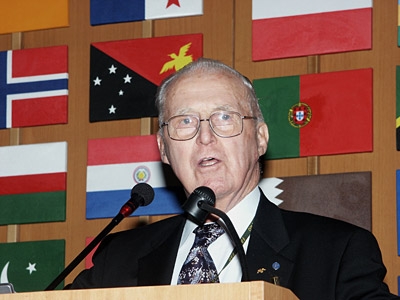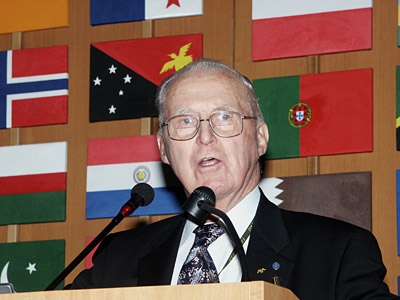 Norman Borlaug (Photo courtesy FAO)In the early 1940s, Mexico was a fraught region for U.S. geopolitical strategists. Not so long before — 1939 — a revolutionary government had nationalized the Mexican oil supply, dealing a sharp blow to U.S. oil interests, especially the Rockefeller family’s dominant Standard Oil. Meanwhile, as war raged in Europe, there was doubt about which side the Mexican government would take — the Allies or the Axis. What if Mexico chose to supply the Germans with oil?
Norman Borlaug (Photo courtesy FAO)In the early 1940s, Mexico was a fraught region for U.S. geopolitical strategists. Not so long before — 1939 — a revolutionary government had nationalized the Mexican oil supply, dealing a sharp blow to U.S. oil interests, especially the Rockefeller family’s dominant Standard Oil. Meanwhile, as war raged in Europe, there was doubt about which side the Mexican government would take — the Allies or the Axis. What if Mexico chose to supply the Germans with oil?
Into that tense milieu, the Rockefeller family’s foundation dispatched a team of agricultural scientists into the Mexican countryside on a mission of goodwill: to bring Mexican farmers the seed varieties, knowledge, and inputs necessary to “modernize” crop production.
As the University of Texas economist Harry Cleaver put it in a 1972 paper in American Economic Review, “The friendly gesture of a development project would not only help soften rising nationalism but might also help hang onto wartime friends.”
One of the junior scientists on that mission would become the best known, eventually netting a Nobel Peace Prize for his work: Norman Borlaug, who died Sunday at the age of 95.
Borlaug is widely hailed as the father of the Green Revolution — the grand effort, which started in Mexican wheat and corn fields in the 1940s, to bring industrial agriculture to the global South.
There’s no evidence that Borlaug thought much about geopolitics during his career as a plant pathologist and evangelist for industrial agriculture. In their book Enough — largely a Borlaug hagiography–the Wall Street Journal reporters Roger Thurow and Scott Kilman portray him as a man almost innocent of politics: He started out with a narrow scientific interest in wheat rust and a desire to “secure a steady job where he could work outdoors”; by the ’60s and for the rest of his long life, he wanted merely to “do what was best for the hungry,” the authors write.
Rather than focusing on the social relations around agriculture, Borlaug honed in on one thing: increasing yield. For him, the complexities of poverty and hunger could be reduced to a single problem: not enough food. From there, the answer was simple: grow as much as possible, using whatever technology available.
For Thurow and Kilman, Borlaug stands as an “international hero, an example of what an individual can accomplish in the quest to end hunger.” That view is conventional, nearly universal. Borlaug’s accomplishments inspire a kind of awe — and rhetorical flights. “A towering scientist” and a “great benefactor of humankind,” declared the U.N.’s Food and Agriculture Organization in a communique after Borlaug’s death. The New York Times called him “the plant scientist who did more than anyone else in the 20th century to teach the world to feed itself and whose work was credited with saving hundreds of millions of lives.”
But it may be that Borlaug’s blindness to politics — his refusal to consider the power relations at work in the countries whose hungry he set out to save — undermined his legacy. His tireless effort to boost grain yields, while no doubt resulting in a flood of cheap grain, created all manner of problems that won’t be easily solved.
In Mexico, to be sure, yields of corn and wheat rose dramatically in the areas where Borlaug’s techniques took hold. But while Thurow and Kilman convincingly argue that Borlaug’s main intent was to “help poor farmers,” Mexico’s smallholders have been in a state of severe crisis for more than a generation. The so-called “immigrant crisis” here in the United States is better viewed as an agrarian crisis in Mexico. Since the the advent of NAFTA alone, more than 1.5 million Mexican farmers have been forced off of their land. Since the Mexican manufacturing economy has been nowhere near robust enough to absorb them, a huge portion of one-time Mexican farmers now wash our dishes and harvest our crops.
While the factors contributing to Mexico’s agrarian disaster are multiple and complex — including neoliberal trade policy and U.S. crop subsidies — the zeal to increase yield certainly factors in. In Borlaug’s Green Revolution paradigm, farmers are urged to specialize in one or two commodity crops — say, corn or wheat. To grow them, they were to buy hybridized seeds and ample doses of synthetic fertilizers, pesticides, and irrigation. (Borlaug’s celebrated “dwarf” varieties can thrive only with plenty of water and lots of synthetic nitrogen, and face serious pest pressure, requiring heavy pesticide doses.) The award for buying into the “Green Revolution package” was a bumper crop. The problem was that when everyone did the same thing and yields spiked, the price farmers received for their crops plunged.
The result is a kind of vicious cycle: farmers scramble to produce more to offset losses, leading to yet more downward pressure on prices. Of course, there’s the temptation to boost yields with yet more inputs like fertilizer — meaning that farmers’ costs could continue creeping up even as the prices they received in the marketplace fell steadily. The result is a kind of structural economic crisis in farming.
The winners in the game are not farmers, but rather the buyers of the cheap commodities (mainly transnational grain processors like Archer Daniels Midland and Cargill) as well as input suppliers (like Monsanto, Dupont, and, again, Cargill) that sell the needed seeds and agrichemicals. As I’ve written before, Mexico’s grain trade — both corn and wheat — has fallen largely under the control of U.S. agribusiness giants, and its culinary staple, the tortilla, has succumbed to a kind of vapid industrialization.
Urban residents do benefit from cheaper food prices, to be sure; but it’s worth emphasizing that in post-Green Revolution Mexico, urban poverty and malnutrition has remained stubbornly persistent, as anyone who has visited Mexico City in the past 20 years can verify.
One of the most ironic things I see in Borlaug obits is the idea that his innovations made countries like Mexico and India “self-sufficient” in food production. Actually, these nations became perilously dependent on foreign input suppliers for their food security.
In India, site of the Green Revolution’s greatest putative triumph, the legacy is even more mixed.
Today in India’s grain belt, less than 40 years after Borlaug’s Nobel triumph, the water table has been nearly completely tapped out by massive irrigation projects, farmers are in severe economic crisis, and cancer rates, seemingly related to agrichemical use, are tragically high.
In other words, to generate the massive yield gains that won Borlaug his Nobel, the nation sacrificed its most productive farmland and a generation of farmers. Meanwhile, as in Mexico, urban poverty and malnutrition in India’s urban centers remained stubbornly persistent.
For me, the point isn’t that Borlaug is a villain and that crop yields don’t matter; rather, it’s that boosting yield alone can’t solve hunger problems in any but the most fleeting way. Farmers’ economic well-being; biodiversity; ecology; local knowledge, buy-in, and food traditions — all of these things matter, too.
As the U.S. and European governments, along with the Gates Foundation, turn their attention to Africa’s hunger crisis, I hope those lessons are heeded — despite Borlaug’s near-canonization as a modern-day saint.




